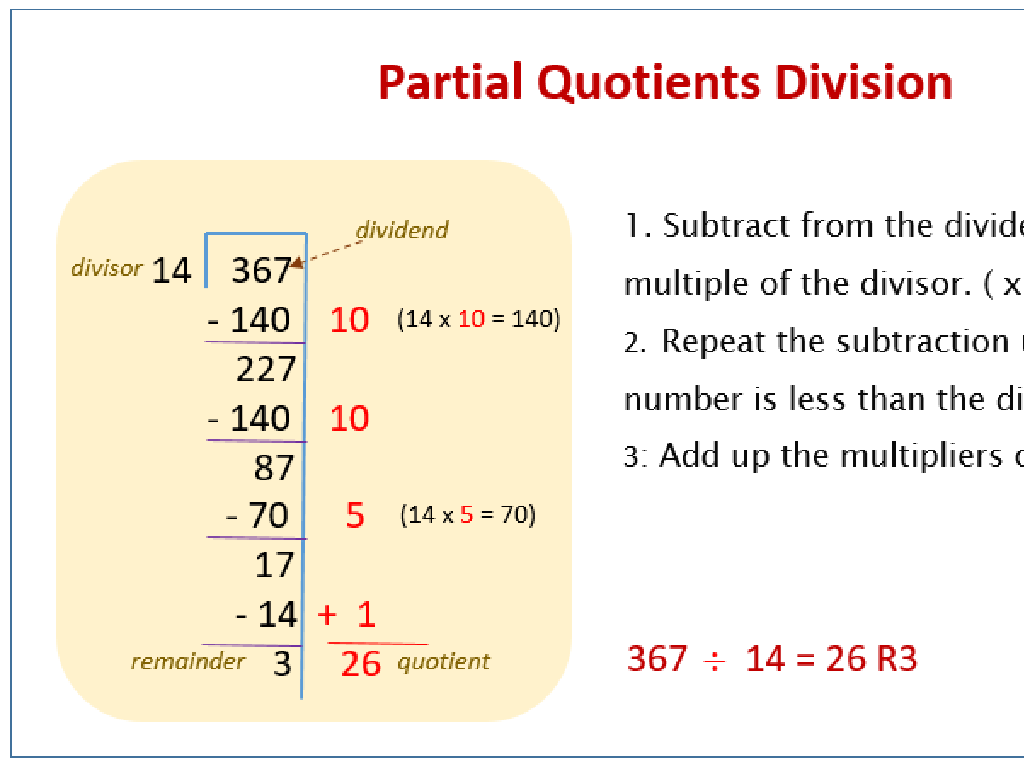Which X Satisfies An Equation?
Subject: Math
Grade: Seventh grade
Topic: One-Variable Equations
Please LOG IN to download the presentation. Access is available to registered users only.
View More Content
Introduction to One-Variable Equations
– Understanding basic equations
– Equations are like puzzles, we find the value of x that makes the equation true.
– Defining one-variable equations
– An equation with only one variable, e.g., x + 3 = 7.
– Real-life equation examples
– Budgeting allowance, or distance traveled over time.
– Solving for x in equations
|
This slide introduces the concept of one-variable equations, which are the foundation of algebra. Start by explaining that equations are statements of equality with unknown values that we need to find. Emphasize that a one-variable equation contains only one unknown, which we often represent with ‘x’. Provide relatable examples such as managing a weekly allowance or calculating travel distance to help students connect the concept to real life. Conclude by demonstrating how to isolate ‘x’ to solve the equation. Encourage students to think of other daily situations that can be represented by equations.
Understanding ‘Satisfy’ in Equations
– ‘Satisfy’ in math context
– To ‘satisfy’ an equation means to make it true by finding the correct value for x.
– How values satisfy equations
– If substituting x into the equation makes both sides equal, then x satisfies the equation.
– Finding the right x value
– It’s like solving a puzzle; the right x completes the picture.
– Significance of correct x
– The correct x ensures the integrity of mathematical relationships and solutions.
|
The term ‘satisfy’ in mathematics refers to the process of finding a value for the variable that makes the equation true. When teaching this concept, emphasize that an equation is like a balance scale; the value that satisfies the equation is the one that keeps it balanced. Provide examples of simple equations and demonstrate how different values of x affect the balance of the equation. Stress the importance of finding the correct value as it is essential for solving more complex problems and understanding the relationships between different mathematical concepts. Encourage students to practice with various equations to become comfortable with the process of finding satisfying values.
Identifying Solutions to Equations
– Define a solution to an equation
– A solution makes the equation true when ‘x’ is replaced with a number
– Testing if ‘x’ is a solution
– Substitute ‘x’ with a number and see if both sides are equal
– Plugging in values to check
– Try different numbers for ‘x’ in the equation x + 3 = 7
– Practice with examples
– Use examples like 2x = 10 to apply the concept
|
This slide introduces the concept of a solution to an equation in one variable. A solution is a value that, when substituted for the variable, makes the equation true. To test if ‘x’ is a solution, students should substitute ‘x’ with the given number and perform the arithmetic to see if the equation balances. Provide examples such as x + 3 = 7 and ask students to plug in values for ‘x’ to find the solution. Encourage students to work through several examples to become comfortable with the process of testing different values. This practice will help solidify their understanding of solutions to equations.
Solving One-Variable Equations
– Techniques to solve equations
– Use inverse operations to isolate ‘x’
– Practice: x + 5 = 12
– Subtract 5 from both sides to find ‘x’
– Find the value of ‘x’
– ‘x’ is the number that makes the equation true
– Verify the solution
– Plug ‘x’ back into the equation to check
|
This slide introduces students to solving simple one-variable equations, a fundamental skill in algebra. Start by discussing various techniques such as inverse operations, balancing equations, and checking solutions. Present the practice problem ‘x + 5 = 12’ and guide students through the steps to solve for ‘x’. Emphasize the importance of finding the value of ‘x’ that satisfies the equation, which in this case is ‘x = 7’. Encourage students to always verify their solution by substituting ‘x’ back into the original equation to ensure it holds true. Provide additional similar problems for students to solve independently, reinforcing the concept.
Let’s Solve Equations Together!
– Solve for x: 3x = 9
– Divide both sides by 3 to find x
– Find x in: 2x – 4 = 10
– Add 4 to both sides, then divide by 2
– Determine x: x/2 + 3 = 7
– Subtract 3 from both sides, then multiply by 2
|
This slide is designed as a class activity to practice solving one-variable equations. For each problem, guide the students through the steps to isolate the variable x. Problem 1 is a simple linear equation where students will learn to perform the inverse operation of multiplication, which is division, to find the value of x. In Problem 2, students will practice two-step equations, first by undoing addition or subtraction, and then by performing division or multiplication. Problem 3 introduces fractions in equations, where students will need to manage additional steps including subtraction and multiplication. Encourage students to show their work step by step and verify their answers by plugging the value of x back into the original equation. Possible activities include pairing students to solve problems together, having volunteers solve problems on the board, or creating a game where students race to solve equations.
Equation Scavenger Hunt Activity
– Find objects representing equations
– Write the object’s equation
– Example: A set of 5 pencils can represent 5x = 15
– Solve equations collaboratively
– Work together to find x for each equation
– Present solutions to the class
– Share how you solved the equations
|
This class activity is designed to engage students in a hands-on learning experience. Students will search the classroom for objects that can be represented by equations, such as a set of pencils that could represent 5x = 15 if there are 5 pencils and they are told the total number is 15. They will then write down these equations and work in teams to solve them, applying their knowledge of one-variable equations. After solving, each team will present their solutions and explain their thought process to the class. This activity encourages teamwork, problem-solving, and practical application of mathematical concepts. Possible variations for different teams could include finding objects that represent different types of equations, such as linear equations, or providing objects that must be used to construct an equation.
Wrapping Up: Mastering Equations
– Recap of solving equations
– Practice makes perfect
– Consistent practice is key to understanding equations
– Homework: 10 equations
– Solve 10 different one-variable equations for homework
– Bring questions next class
– Note any difficulties to discuss
|
As we conclude today’s lesson on solving one-variable equations, it’s crucial to emphasize the importance of practice. Mastery in mathematics comes from repetition and engagement with various problems. For homework, students are assigned to solve 10 one-variable equations, ensuring they apply the methods learned in class. Encourage them to attempt each problem and bring any questions or challenges they face to the next class for discussion. This will not only solidify their understanding but also help identify common areas where students may struggle, allowing for targeted review in future lessons.





